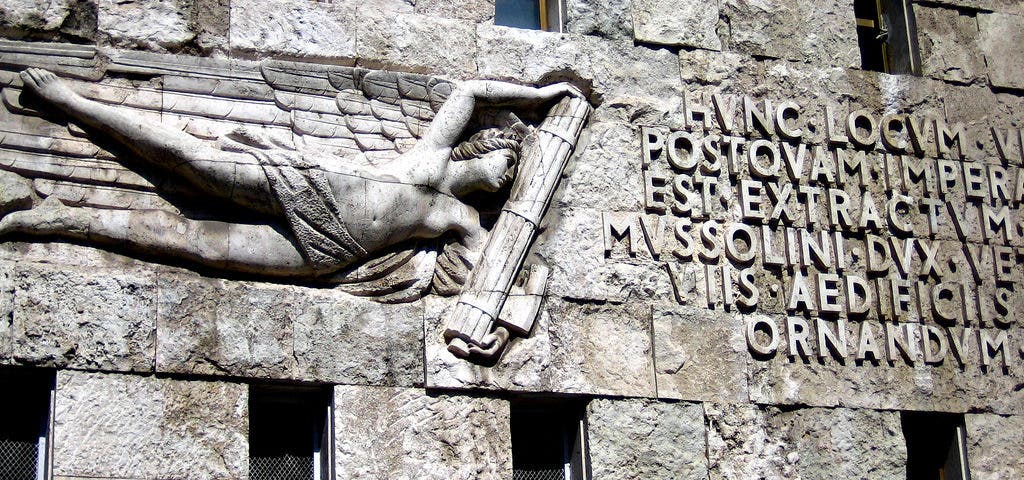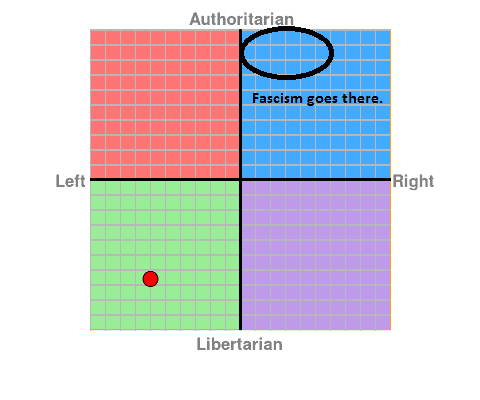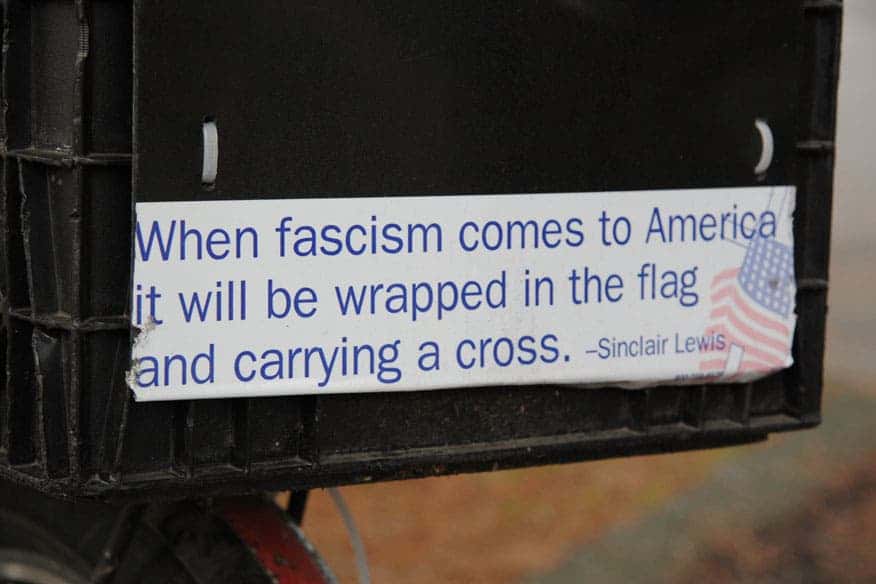Heavily stigmatized in the aftermath of World War 2, “Fascism” is a term you don’t hear that much anymore — except thrown around in heated political debates as an ultimate insult. But what is fascism as a political system, and are the concerns that it may be making a comeback valid? Let’s find out.

Image credits Anthony Majanlahti / Flickr.
Throughout history, people have envisioned and established a myriad of ways to order our societies and define social roles in the grand scheme of things. The shape these systems took, the power they held over various aspects of life, and their relationship to other political systems all evolved in accordance to several factors: a society’s leaning towards secularism or religiousness, traditionalism or liberalism, its overall level of education and ability to exchange ideas, and of course, technological capability.
The basics
Fascism actually emerged (in a coherent form) in Italy, not Nazi Germany. Its roots start to form in 1915 from a people marked by the death, horror, and the (soon to be) vittoria mutilata of the Great War, and it grew on the unprecedented technological and industrial progress of the 20th century. Since then, as Godwin’s tongue-in-cheek law perfectly exemplifies, “fascist” has become an almost derogatory term evoking rigidity and extremism of thought, allegiance to an oppressive single party, violence against anyone not aligned with the ideology, xenophobia, and an exclusion of the one it’s aimed at from any meaningful discussion in politics.
But beyond a few characteristics that define all fascist movements, they draw heavily from a people’s culture and can be very different from one another. So let’s take a look at what this political system stands for, what circumstances led to its creation, and what place it has in the world today.
First things first: political analysts usually classify ideologies as wings on a “left-right” spectrum. At their best, the left wing deals in change, progressive ideas, believes the state has the responsibility to care for its citizens (things like basic income, state-owned health, emergency, education systems are at home on the left), are generally idealist and value equality. The right deals in conservative ideas, believes in free markets as well as minimal state interference and regulation (ultra-free markets, private health, emergency, and education systems thrive under right-wing rule). The right emphasizes equity over equality.
I’ll also take a cue from the guys at PoliticalCompass and factor in a social spectrum to get a better understanding of fascism. So in addition to the left-right poles, we’ll also put in an authoritarian-libertarian scale which shows how different governments go about their business: by pooling power within the ruling body and/or a central figure (authoritarian), or by allowing people greater freedoms, thereby giving away their power (libertarian). Now that we have our bearings, let’s talk fascism.
What is fascism?

Image credits The Political Compass.
It’s pretty hard to determine the exact boundaries of fascism. In broad lines, however, it’s considered to fall on the heavily authoritarian right as it maintains social order and opposes equality — here it’s in the top bits of the blue area. In other words, fascism relies on a mix of government or single leader with virtually absolute power in society and strong private property that only remains free while it serves the party’s interests.
It also has deep, super-nationalistic and racist, even xenophobic undertones, creating a sense of ‘us vs them’, blaming the perceived other for the country’s hardships, eventually encouraging segregation and violence against this ‘other’ as the way forward.
From a socio-economic standpoint, fascism is highly polarizing: exceedingly rich and powerful industrialists and politicians rule at the top, followed by upper, middle, then lower classes, with one or more groups of non-citizens at the bottom. But none of these truly define fascism (in fact, we can see many of its influences in today’s politics, even though we don’t live under fascism).
What fascism usually does is reject liberal, socialist, and conservative thoughts and replaces them with a complex net of cultural and ideological tenants. This cultural element is why it’s so hard to tell exactly where fascism begins and ends. Fascist rulers attain the people’s mandate by pointing at the glories of yore and their subsequent decadence, instilling a sense of superiority over other peoples (the corruption of the Ubermensch symbol), and insisting that only a strong country united under a strong leader can retake their place on the world stage (“Make America great again“) all of which takes the shape of unique cultural levels in every society.

Image credits Robert F. W. Whitlock / Wikimedia.
The final traits of fascism are heavy propaganda, a rejection of globalization and attainment of autarky, a mixture of philosophies and ideas from the left and right into its ideology and, perhaps it’s most extreme far-right trait, the aim to have a group of superior people dominate society and purge inferior humans.
Tying it all together, the very name of “fascism” is probably what symbolizes this ideology the best. The word is rooted in the Latin word fasces, which were bundles of rods usually tied around an axe with the blade sticking out. Fasces were issued to Roman magistrates and symbolized power. And in a way, that’s what fascism is: a people inescapably tied to a single cause, vesting absolute power and the decision of life and death in a leader’s personal agenda — whether willingly or by force.
One interesting observation you can make from the four quadrants in the above compass is that it’s not communism which is ideologically opposite fascism — the two are actually pretty similar apart from the fact that communism rejects traditional elites while fascists work them into the new social order. The ideological opposite of fascism is liberal socialism. That’s some food for thought.
How does fascism emerge?
The first truly fascist party emerged in Italy in the 1920s. To give you some context, at the conclusion of the World War I Italy lost an estimated 400,000 soldiers, and almost four million of the country’s men were wounded, captured, or suffered disease and disability after the conflict in the army alone — in a country of 37 million people at the time. That’s over 10% of the whole population. It’s a huge ratio.
For all their hardship and loss, the Italians also felt they were cheated out of the war promises the Entente (basically the allies in WWI) made. Initially allying with Germany and Austro-Hungary to defend against French expansion in Tunisia, one of their African colonies, the Italians secretly agreed to join the Entente in the London Pact — on the condition that they are given back north-eastern Italy from the Austrians. After the treaty was signed, however, UK diplomats figured that they didn’t actually have any beef with the Austrians. Long story short, Italy didn’t get what it was promised when the Treaty of Versailles, which ended WWI, was signed.

Image credits Nicklaarakkers / Wikimedia.
This could be seen as the first spark to ignite fascism in Italy at the time. Public confidence and approval of the then-Prime Minister Vittorio Orlando tanked as people regarded him too weak to serve Italian interests. Poet Gabriele D’Annunzio, the one who coined the term “vittoria mutilata,” started to vocally criticize Orlando’s weakness and the treachery of foreign powers. He gathered a small force of armed Italians and actually attacked and conquered the city of Fiume in September 1919, then part of Austria — a 90% ethnic Italian town that the country was promised but didn’t receive as war reparations. The town subsequently issued what amounted to a fascist charter and enjoyed autonomy for a while.
And it may well be this charter that took fascism, in the public’s opinion, from one of many possibilities to a solution. As always, there was still internal resistance, but for many people disillusioned with Italy’s current government, angry about what they perceived as unfairness by external powers, and willing to see Italy’s sacrifices properly repaid, this new political idea actually delivered — it managed, with 2,000 or so armed men, to capture a city that the previous government couldn’t bring back with a whole war.
Germany also had to pay huge war reparations and suffer international shame (it was a thing back then) following the end of WWI, and unlike Italy, they also had to contend with the fact that they actually lost. The reparations ruined Germany’s economy, and I mean actually ruined — inflation was so high in post-war Germany that you needed a literal wheelbarrow of cash to buy a loaf of bread. People would even burn money in stoves to heat their homes during the winter since it was less expensive than buying coal or firewood.
In these conditions, it’s not that hard to understand how desperate people would look to a strong government to solve their problems.
While it’s easy to judge past generations on their actions, we have the benefit of hindsight on our side. Even so, the threat of fascism still looms over us, and will likely haunt our elections and governments for a while still.
Fascism today

Fascism was made possible by the breathtaking speed of technological advance in the 20th century, one which overcame society’s ability to adapt. People wanted safety and more bountiful lives following the horrors of the Great War, and autocrats scrambling for ever-more power, with massive industrial and infrastructure complexes behind them, could provide that.
Technology such as radios let the government speak directly to the people, and nobody knew not to trust their government yet so they did the unthinkable things their leaders said would bring about a better world — and are we really the ones to judge them? We are living in an increasingly illiberal world, where our hate and fear push more autocratic leaders into the spotlight. We fear our way of life is under attack by terrorists, more and more people are struggling with poverty, and most people haven’t yet learned not to trust that Facebook post from a random site claiming “immigrants are taking our jobs” and “causing crime” (both are false) — so we do the unthinkable things our leaders ask of us to bring about a better world.
Just as in those early days of economic and political uncertainty, we’re putting our faith in strong leaders who look willing to fight for our interests. A leader who comes with promises of a wealth, safety, a sense of purpose for all — and that’s perfectly understandable. But the people who promise you can have all that if you just kick out x minority, or if you reclaim your borders, the people who hate and discriminate — they won’t solve our problems. They won’t do anything except breed more hate and discrimination, more misery and hardship for those in need, more power and wealth for those who further their goals. Talking about the issue of fascism for The New York Times, Henry Scott Wallace wrote:
“They invariably put ‘money and power ahead of human beings.’ […] ‘They demand free enterprise, but are the spokesmen for monopoly and vested interest, […] claim to be super-patriots, but they would destroy every liberty guaranteed by the Constitution’.”
“They bloviate about putting America first, but it’s just a cover. ‘They use isolationism as a slogan to conceal their own selfish imperialism.’ They need scapegoats and harbor ‘an intensity of intolerance toward those of other races, parties, classes, religions, cultures, regions or nations’,” he concludes.
Today we do have the benefit of hindsight. We know what lies down the path of fascism, be it in America, in Russia, the UK, or any other country — if it takes root, this time it’s on us.






